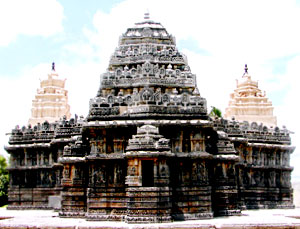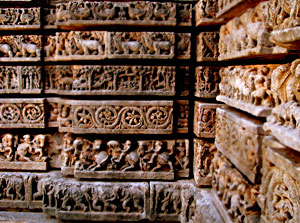 Sculpture of the Lakshmi Narasimha Temple has been intricately done on stone. From the base of the wall, the first horizontal layer contains procession of elephants, above which there are horsemen and then a band of foliage. The second horizontal section has depictions from the Hindu epics and Indian Puranas executed with detail. There are two friezes of yalis (imaginary beast) and hamsas (swans). The vimana tower is more ornate than the walls. A large open hall with tall pillars with "faces" was added during later times. There are three tiers of decorative smaller roofs. The wall images of Gods and Goddesses are below the lower eaves. There are 120 such sculptured panels below. This is a good example of a richly decorated Hoysala temple built in the trikuta vimana style with fine sculptures that adorn the walls.
Sculpture of the Lakshmi Narasimha Temple has been intricately done on stone. From the base of the wall, the first horizontal layer contains procession of elephants, above which there are horsemen and then a band of foliage. The second horizontal section has depictions from the Hindu epics and Indian Puranas executed with detail. There are two friezes of yalis (imaginary beast) and hamsas (swans). The vimana tower is more ornate than the walls. A large open hall with tall pillars with "faces" was added during later times. There are three tiers of decorative smaller roofs. The wall images of Gods and Goddesses are below the lower eaves. There are 120 such sculptured panels below. This is a good example of a richly decorated Hoysala temple built in the trikuta vimana style with fine sculptures that adorn the walls.
An interesting feature of Lakshmi Narasimha Temple, Nuggehalli is that inspite of being trikuta it appears as an ekakuta from the outside. This is because of the fact that the other two lateral shrines are just extensions that project out from the walls of the mandapa. An open spacious hall with sculpted faces was later added. Thos construction made the original porch and the closed mandapa appear as the inner part of the temple. The kalasa that is generally found on the shikhara is missing here. It is interesting to note that the tower here is built in nagara style (North Indian style).
The eaves that run around the Lakshmi Narasimha Temple suggest that it is an architectural instance of later Hoysala period. There are two sets of eaves.  The lower eaves have been carved out just one meter below the upper ones. In between these lies a decorative miniature tower. Below the lower eaves a panel of sculpted figures of several Hindu deities and their attendants appear. There are 120 sculptured panels. Some of the finest sculptures of Hoysala style are to be found on the friezes. Here one will come across procession of elephants, horses and men riding horses. These sculptures are intricate and done in details. The vimana tower is also profusely decorated with sculptures. These are more ornamental than the outer walls of Lakshmi Narasimha Temple. Icons of Lord Shiva are also a part of the sculpture of this Hoysala Lakshmi Narasimha Temple.
The lower eaves have been carved out just one meter below the upper ones. In between these lies a decorative miniature tower. Below the lower eaves a panel of sculpted figures of several Hindu deities and their attendants appear. There are 120 sculptured panels. Some of the finest sculptures of Hoysala style are to be found on the friezes. Here one will come across procession of elephants, horses and men riding horses. These sculptures are intricate and done in details. The vimana tower is also profusely decorated with sculptures. These are more ornamental than the outer walls of Lakshmi Narasimha Temple. Icons of Lord Shiva are also a part of the sculpture of this Hoysala Lakshmi Narasimha Temple.



















